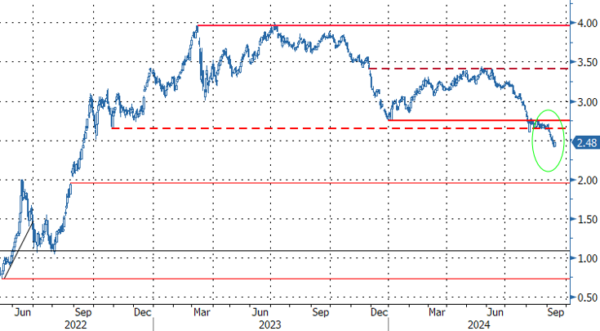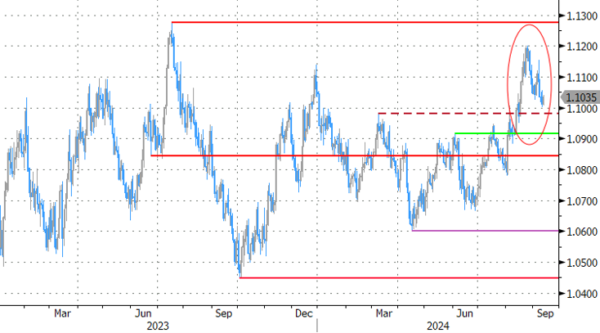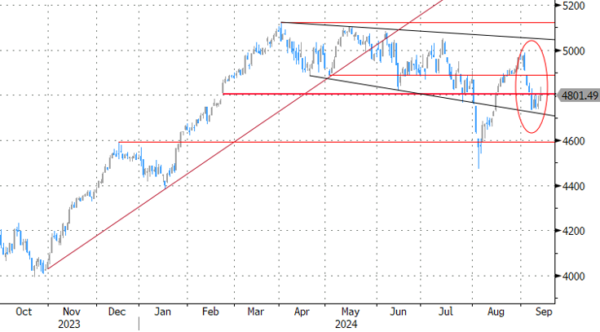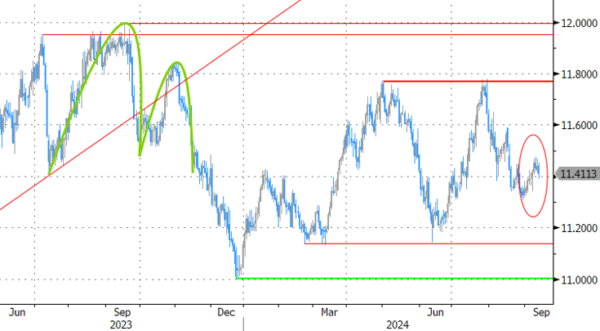Markets
The US was at the center of attention yesterday with the August inflation figures. The spotlights today were aimed at Frankfurt. The European Central Bank delivered on the widely expected 25 bps rate cut that brought the deposit rate at 3.5%. It cut the MRO and MLF rates by 60 bps (3.65% and 3.90% resp.) in a technical adjustment to narrow the corridor again. In a system of excess liquidity this has no practical implications and says nothing about the monetary stance as such. Updated forecasts showed no change to the headline inflation outlook compared to June: 2.5%, 2.2% and 1.9% through 2024-2026. Core inflation was upped slightly to 2.9% and 2.3% for the running and next year, owing to higher-than-expected services inflation. Still-elevated wages are responsible but the ECB is seeing those labour cost pressures moderating. Core inflation should eventually decline to 2% in 2026 (no change). Growth was lowered 0.1 ppts across the policy horizon (0.8%, 1.3% and 1.5%) mainly due to a weaker contribution from domestic demand. With the recovery continuing to face headwinds, growth risks remain tilted to the downside. These growth & inflation dynamics as well as growing conviction of reaching the 2% target (especially over 2025) allow for a lesser degree of monetary restriction but ongoing vigilance remains warranted. The ECB sticks to a data-dependent approach and does not pre-commit to anything. Given the short time span between this meeting and the next – Lagarde during the presser confirmed the 6-week span is indeed limited – we believe the ECB will skip the rate cut occasion on October 17 and gets back at it in December. Questions about what to expect next/beyond October were easily deflected. Lagarde obviously did not want to validate current market expectations of (give or take) another 50 bps of cuts this year and instead explained painstakingly detailed how they came to today’s unanimous decision. Lagarde also took her time to throw some flowers to her predecessor Draghi and his extensive report earlier this week. That says something on her intentions of not wanting to reveal anything that carried a shred of new information. Markets reacted accordingly with near-zero movement in EUR/USD (1.103) or yields. German rates do add between 1 (30-yr) and 5.2 bps (2-yr) but the bulk of the move happened already before the decision. The ECB outcome coincided with some second-tier US data. But both jobless claims (230k) and PPI numbers (headline 0.2% m/m and 1.7% y/y, core 0.3% m/m and 2.4%) came in too close to expectations to move a needle.
News & Views
Swedish headline inflation fell by 0.6% M/M in August, more than the 0.4% decline expected. Headline inflation fell below the Riksbank’s 2% inflation target for the first time since July 2021 (1.9% Y/Y from 2.6% vs 2.1% expected). The central bank’s preferred CPIF inflation gauge (using fixed mortgage rates) similarly fell by 0.5% M/M to 1.2% Y/Y (from 1.7% vs 1.4% consensus). Excluding energy, CPIF fell by 0.3% M/M to stabilize at 2.2% Y/Y. Food (-0.4%), electricity (-6.1%), transport (-2.7%) and package holidays’ prices (-19.1%) all decreased in August. Higher clothing prices (+5%) only partly offset these price drops. Today’s inflation numbers strengthen market bets that the Swedish central bank will cut its policy rate at all of this year’s three remaining policy meetings, the upper end of the Riksbank’s own 2 to 3 times guidance. The Swedish krone didn’t suffer from the CPI miss (EUR/SEK 11.44). Next month, Statistics Sweden will introduce flash estimates for inflation, called Flash CPI. The Flash CPI is a preliminary figure and will be published five working days before the regular publication (first release Oct 8).
The International Energy Agency released its September Oil Market Report. Global oil demand growth continues to decelerate, with reported 1H24 gains of 800k b/d y/y the lowest since 2020. The chief driver of this downturn is a rapidly slowing China. Outside of China, oil demand growth is tepid at best. World supply rose by 80k b/d to 103.5m b/d, with outages caused by a political dispute in Libya combined with maintenance in Norway and Kazakhstan offset by higher flows from Guyana, Brazil and elsewhere. The IEA fears that OPEC+ may be staring at a substantial surplus even if its extra curbs were to remain in place with non-OPEC+ supply rising faster than overall demand. Early September, the oil cartel announced to postpone by two months the start of their planned unwinding of extra voluntary production cuts. Brent crude prices fell from $80/b+ levels at the start of the month to currently $71/b on growth slowdown/recession fears.
Graphs
European 2-yr swap yield unhindered by telegraphed ECB rate cut. Looks for a return higher after hitting 2.4% support yesterday.
EUR/USD shrugs at today’s policy decision as ECB offered no guidance on what to expect next.
EuroStoxx50 stages a cautious rebound after kicking off September on terrible footing.
EUR/SEK: Swedish crown holds steady despite CPI miss boosting bets for 3 more Riksbank rate cuts this year.
















